UK Release date : Friday, June 10, 1966
Paperback Writer / Rain (UK)
By The Beatles • 7" Single • Part of the collection “The Beatles • Singles”
Last updated on December 9, 2023
UK Release date : Friday, June 10, 1966
By The Beatles • 7" Single • Part of the collection “The Beatles • Singles”
Last updated on December 9, 2023
Previous single May 30, 1966 • "Paperback Writer / Rain (US)" by The Beatles released in the US
Session Jun 09, 1966 • Recording and mixing "Good Day Sunshine"
Article Jun 10, 1966 • "Yesterday and Today" butcher cover is being withdrawn
Single Jun 10, 1966 • "Paperback Writer / Rain (UK)" by The Beatles released in the UK
Interview Jun 11, 1966 • Paul McCartney interview for Disc And Music Echo
Article Jun 12, 1966 • The Beatles meet The Mamas & The Papas
Next single Aug 05, 1966 • "Yellow Submarine / Eleanor Rigby (UK)" by The Beatles released in the UK
This album was recorded during the following studio sessions:
Recording "Love You To", "Paperback Writer"
Apr 13, 1966
Recording "Paperback Writer", "Rain"
Apr 14, 1966
Apr 16, 1966
2:28 • Studio version • A
Paul McCartney : Backing vocals, Bass, Electric guitar, Lead vocals Ringo Starr : Drums John Lennon : Backing vocals, Tambourine George Harrison : Backing vocals, Electric guitar George Martin : Producer Geoff Emerick : Recording engineer
Session Recording: Apr 13, 1966 • Studio EMI Studios, Studio Three, Abbey Road
Session Overdubs: Apr 14, 1966 • Studio EMI Studios, Studio Three, Abbey Road
Session Mixing: Apr 14, 1966 • Studio EMI Studios, Studio Three, Abbey Road
3:01 • Studio version • A
Paul McCartney : Backing vocals, Bass Ringo Starr : Drums, Tambourine John Lennon : Backing vocals, Electric guitar, Lead vocals George Harrison : Backing vocals, Electric guitar George Martin : Producer Geoff Emerick : Recording engineer
Session Recording: Apr 14, 1966 • Studio EMI Studios, Studio Three, Abbey Road
Session Overdubs: Apr 16, 1966 • Studio EMI Studios, Studio Two, Abbey Road
Session Mixing: Apr 16, 1966 • Studio EMI Studios, Studio Two, Abbey Road
From Something Else!:
[…] It had been a while since they released their previous single, “We Can Work it Out”/”Day Tripper” in December of 1965, so the band was overdue for a new one. “Paperback Writer” and “Rain” were chosen to grace the first Beatles single of 1966, and were released in the U.S.A. on May 30; the U.K. release followed on June 10. “Paperback Writer” has been considered the A-side, not surprisingly as it is the more spirited and catchy of the two. However, the picture sleeve listed it first on one side and second to “Rain” on the other. If Mark Lewisohn is the final arbiter, then the appendices for Chronicle book lists “Paperback Writer” alone in the lists for the Beatles’ Peak Singles, sandwiched between others that were listed as actual double A-sides (“We Can Work It Out”/”Day Tripper” and “Eleanor Rigby”/”Yellow Submarine”).
While the single quickly shot up both the U.K. and U.S. charts, it lasted only one week at No. 1. Lewisohn notes that it was the Beatles’ lowest-selling single since their very first, “Love Me Do.” At this point in their career, the Beatles were blazing through new trails, turning their attention to increasing the creativity of their music and recordings in light of seeing the end of exhausting and unproductive touring — and it might have take a while for the public to catch up. One can surmise that the content of these two songs caught the fickle female records-buying public by surprise, and after hearing the songs on the radio were not as interested in purchasing a single where the subjects were about a desperate job hunter and the weather – instead of, well, the girls themselves. […]
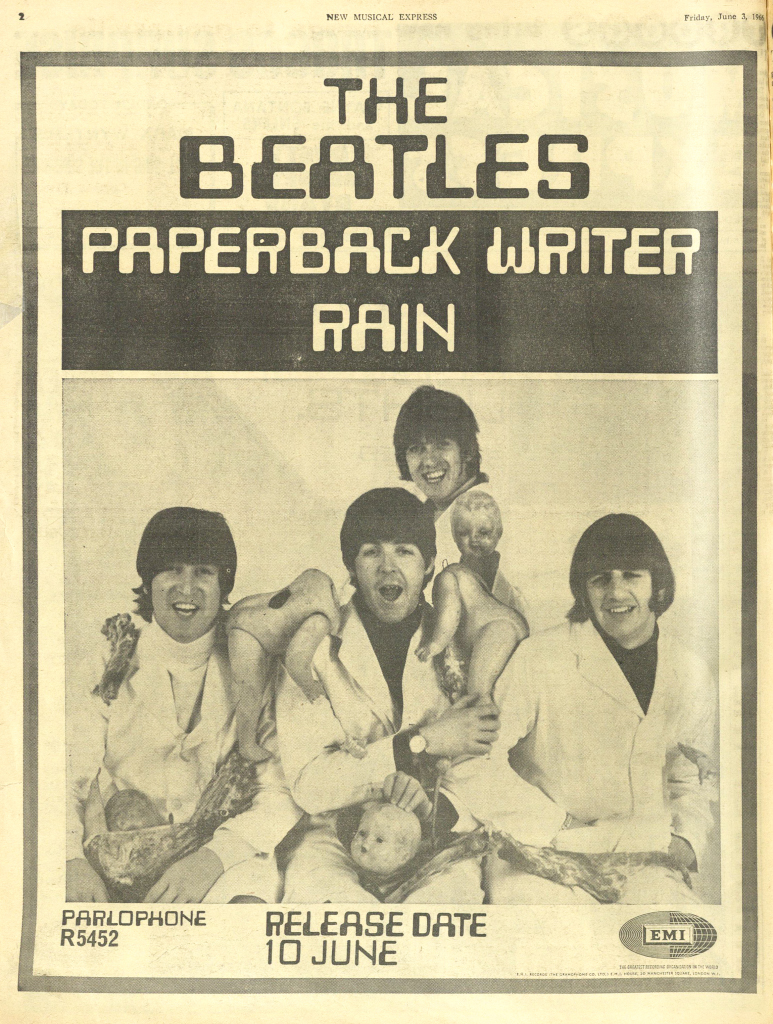
BEATLES PLAN THE NEW SINGLE
THE Beatles’ follow-up to their last number one hit “We Can Work It Out” / “Day Tripper” — which jumped into the MM Pop 50 on December 18 and held the top spot for four weeks until January 8 — will be recorded at a two-day session in London next week.
The single — expected to be released in about six to eight weeks — will be selected from 15 songs that the Beatles have spent the past few weeks writing and rehearsing ready for the recording session immediately after Easter.
The remaining tracks after the single has been selected will be used on the Beatles’ next LP release — their successor to the best-selling “Rubber Soul” album, released on December 10 and containing 14 tracks, many of which have been covered — and made into hits — by other artists.
It’s virtually certain that as in the case of “Rubber Soul”, unusual instruments and instrumental effects will be used on the new recording session. No details of tracks were available at press time, however.
From Melody Maker – April 9, 1966

STANDBY FOR BEATLE SINGLE
THE Beatles’ new single — their first since “We Can Work It Out” / “Day Tripper” was in the charts in December, January and February — is “Paperback Writer”, coupled with “Rain.”
The record will be released on Friday, June 10 in Great Britain, and on June 6 on Capitol in the States. Both songs are Lennon and McCartney compositions and unusual instruments, like the sitar featured on “Norwegian Wood”, are not featured on either track.
The A side, “Paperback Writer”, features Paul singing the main verses with John and George joining him on the choruses. It tells the story of a man who needs a job and is writing a letter to book publishers trying to get a story published.
The B side, “Rain”, features John, with John and Paul joining in on the word “rain”. The lyric suggests that whatever the weather, someone will always complain.
Beatles’ recording manager George Martin told the MM: “These two numbers were the obvious choice for the new single out of all the tracks recorded at the recent sessions. The rest of the tracks will make up the new LP.”
At presstime, no promotional TV or radio dates had been lined up for the Beatles.
From Melody Maker – May 7, 1966
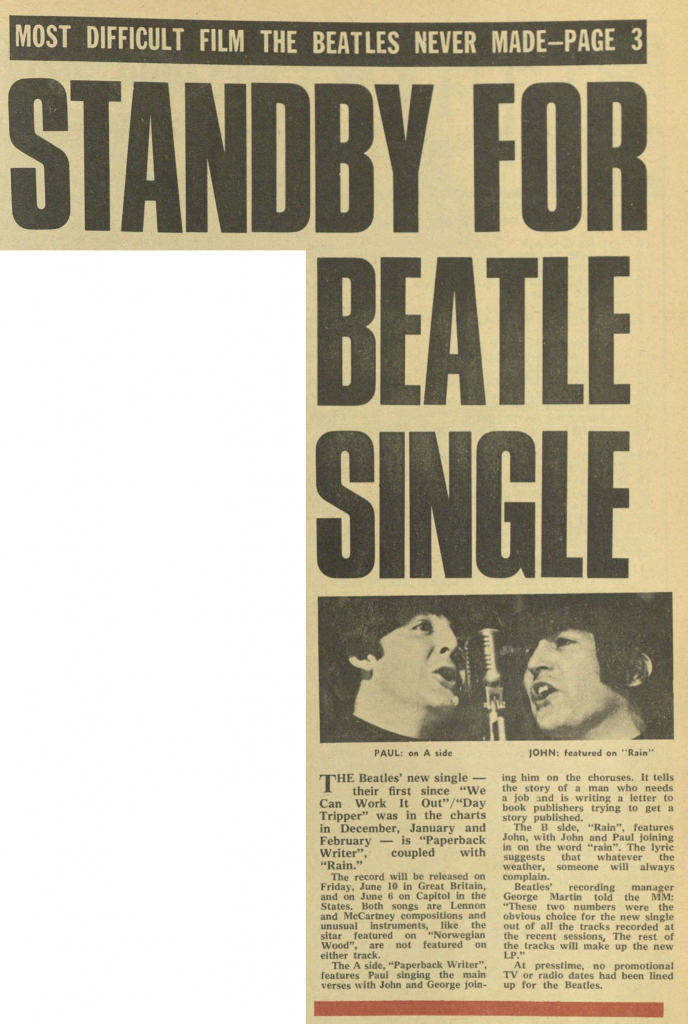
Can the Beatles topple the Stones?
Both are, of course, excellent Beatles tracks. And after playing the sides to me this week, George Harrison said: “We think it’ll turn out to be another record like ‘Day Tripper’ and ‘We Can Work It Out’.“
CONTROVERSY about which side of the new Beatles’ single should be the A track is almost certain to break out when “Paperback Writer” and “Rain” go on sale on June 6.
“A lot of people said they preferred the B side on that. But it takes time to get some of our stuff across — and anyway, if they think the B side is better than the A, it means we’ve produced two good songs, doesn’t it?”
“Paperback Writer” is fast, with Paul taking a good vocal on some exceptionally clever words. Paul also features a heavy guitar riff which helps punch the song across, and the track is very catchy.
Says George: “The idea of ‘Paperback Writer’ is Paul’s. I think John gave him some of the words, but it was originally Paul who came up with the story-line.”
The track opens with Paul, John and George singing “Paperback Writer” in chorus — “sort of Beach Boys style, if anything, I suppose,” explained George. It fades out at the end.
“Rain” is more plaintive and pretty, and a typically attractive slow Beatles melody. John takes lead vocal, and the lyrics are based on the fact that whatever the weather, somebody will always complain. It will probably prove as popular with Beatles fans as “Yes It Is”. That, too, was a B side, of course.
ARE THE BEATLES WORRIED THAT THIS TIME THEY WON’T HIT THE TOP SPOT FIRST TIME?
“Well, this keeps coming up and it’s virtually impossible to answer,” George replied. “We just know we are making better records, but we get less satisfied than ever. The fact that they sell a lot isn’t enough any more. We’re interested in getting better sounds, and if the new sounds of the group don’t go down so well as the OLD sound, well, I don’t know what to say…
“We’ve all got the attitude of: well, if it doesn’t go to the top in the first week, that’s that. There’s nothing more we can do. We’ve made the record. Now it’s up to the people who buy it.”
George went on to say that the Stones would probably be at the top by the time their new single came out. “Let’s hope we can do it — that’s all,” the Beatle added.
“One of the songs on our new LP is amazing. It’s nothing like a pop song. I wonder how it’s going to be received — I’ve been told that years ago, when Ornette Coleman came along with his new sounds in jazz, everybody thought he was a bit weird. Perhaps we can do that as well— change the scene a bit and start some new sounds.”
George thinks “Paperback Writer” and “Rain” is their best single so far. “Better than the last one, definitely. The sound’s better and the songs are, too.”
Harrison has written two songs for the Beatles’ new LP, out in the summer. “One’s completely finished, but with the other I’m not very happy with the lyrics.” He uses the sitar again, and photographer Bob Freeman is working on the possibility of a revolutionary sleeve jacket for the album — “he’s talking about having it done in silvery colour, or put out just like a photo negative,” said George.
One of George’s songs on the new album is “I’m Only Sleeping” — “and we try to get the vocal to sound like somebody’s asleep, which is very difficult!”
George added that there were several songs, now set for the LP, which could have been considered for the new single. “But we decided ‘Paperback’ had the best single sound about it.”
Did the Beatles think there had been too long a gap between ‘Day Tripper’ and ‘Paperback Writer’? Their last single was in the chart in January and February.
“I’m inclined to think it has been a bit too long, but there’s nothing we can do about that,” George answered. “It was a bit of a long gap, but we’d rather wait and be sure. And that’s what we did.“
The wait has been worthwhile. “Paperback Writer” and “Rain” are excellent Beatles songs which will give the summer a hot start.
From Disc And Music Echo – May 14, 1966
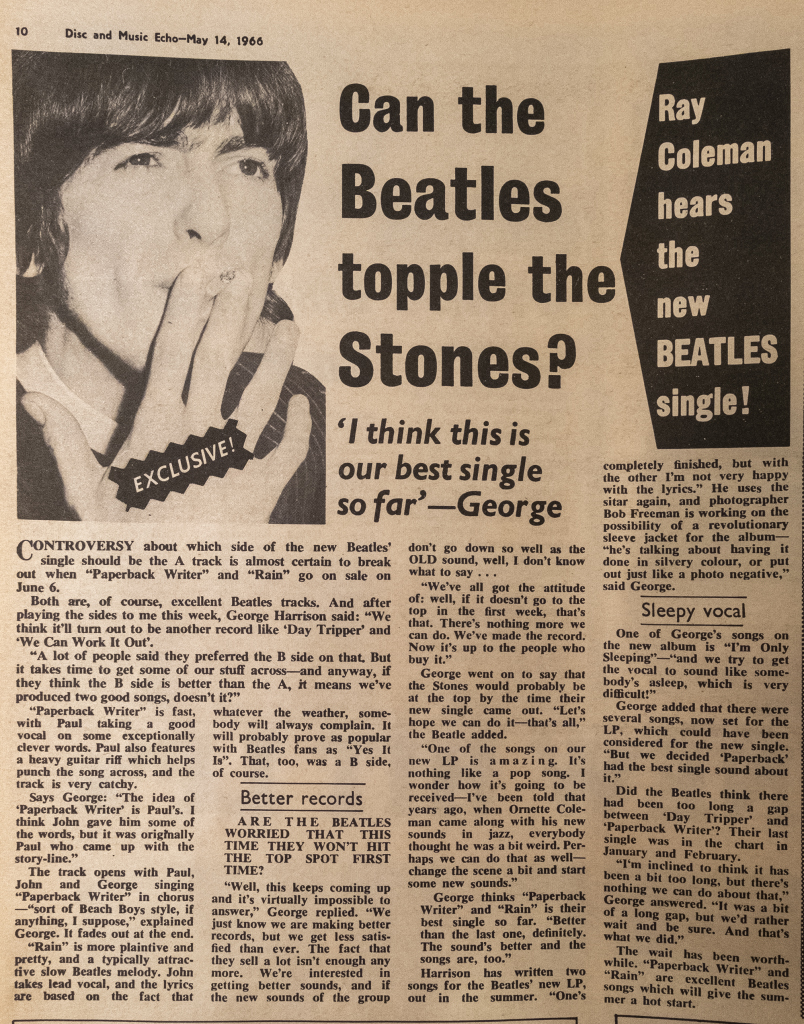
lndian pop, using wailing harmony and dipping bass lines
THE BEATLES: “Paperback Writer” (Parlophone): It’s here, the brand new Beatles’ single. From the pen of John and Paul, they subtly follow the trait towards Indian pop using wailing harmony and dipping bass lines. A very swinging track with a lot of impact, some vicious sounds, and almost disconcerting vocal harmonies. Producer George Martin has obtained a very powerful overall sound with some excellent timing on the vocal echo. John [sic – Paul] sings in rather a strained, urgent, cry about the man who wants to be a paperback writer with George and Paul soaring behind him. Many falsetto harmonies over George’s heavy, churning guitar. Certainly right up to Beatles standard and needless to say — a huge hit.
From Melody Maker – June 4, 1996
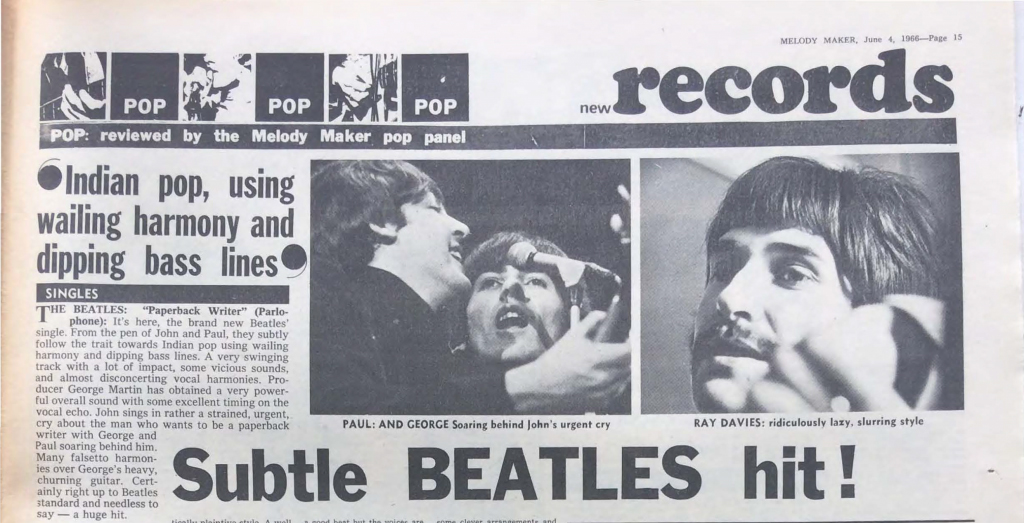
BEATLES SINGLE No. 12
But shock over new album—not until August!
THE title and release date for the Beatles’ twelfth single were announced this week — but there was surprise news of their seventh album, which will not be released until late summer ! Title of the new single is “Paperback Writer” and the coupling is “Rain”; both sides are of course Lennon-McCartney compositions. The disc will be issued on Friday, June 10 — six months and a week after their last, “Day Tripper”/ “We Can Work It Out.”
“Paperback Writer” features Paul’s voice double-tracked, and tells the story of a journalist who is frustrated by his efforts to get a novel published. John double-tracks on “Rain,” a slower number about the weather and how people complain about it.
Although the Beatles have been recording for four weeks. their next LP is still not complete, and they have temporarily suspended recording sessions. The album is not planned for release before August.
From New Musical Express – May 6, 1966
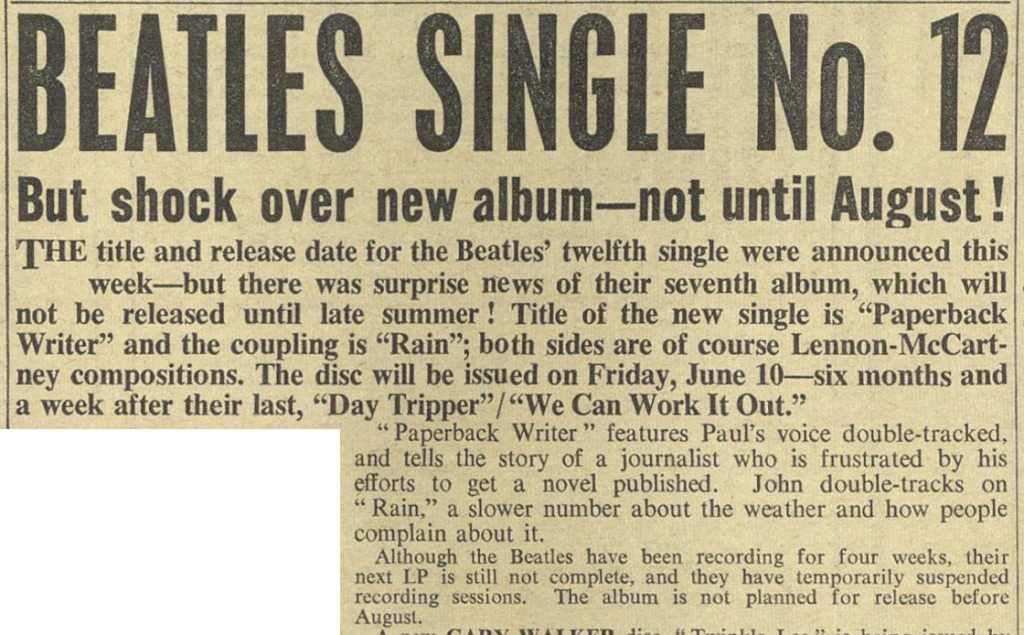
Startling, even for the Beatles! “Paperback Writer” / “Rain” (Parlophone)
CHANCES are you’ll already have heard this, so I won’t dwell on it too lengthily. Top side swings along at a thundering pace, with Paul dual-tracking the lyric, aided by some of the most startling harmony chanting even the Beatles have ever come up with.
Great cymbal-bashing by Ringo emphasises the drive – and those sudden breaks in tempo help to increase the impact.
From New Musical Express – June 3, 1966
FLIP: Tempo slows to medium pace for this philosophic ditty. John’s vocal is enhanced by background harmonies and a shuffle beat.

New-sound Beatles rocket to No 1 spot
THE BEATLES have gone from nowhere straight to the top of the pops with their new disc “Paperback Writer.” After only two days in the shops, the record hit the No. 1 spot in the “Melody Maker” chart yesterday. In the “New Musical Express” chart, it reached second place, leaving Frank Sinatra at No. 1 with “Strangers in the Night.”
The success of “Paperback Writer,” their first “single” of 1966, surprised even the Beatles themselves. “It’s not our best single by any means,” said Paul McCartney yesterday. “But we’re very satisfied with it. We are experimenting all the time with our sound. We cannot stay in the same rut.” And Paul made a prediction: “We have got to move forward… Our new LP is going to shock a lot of people.”
From The Daily Mirror – June 14, 1966


Notice any inaccuracies on this page? Have additional insights or ideas for new content? Or just want to share your thoughts? We value your feedback! Please use the form below to get in touch with us.